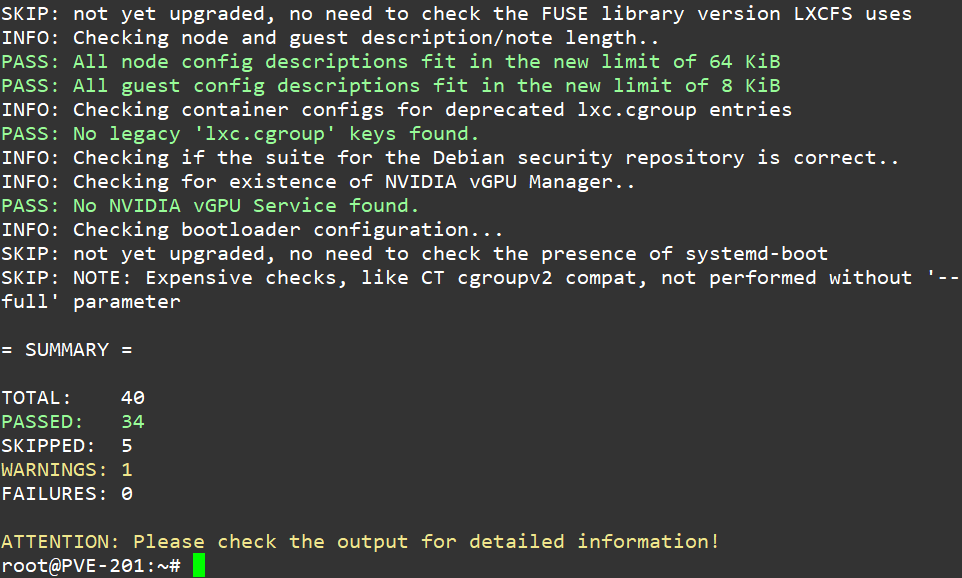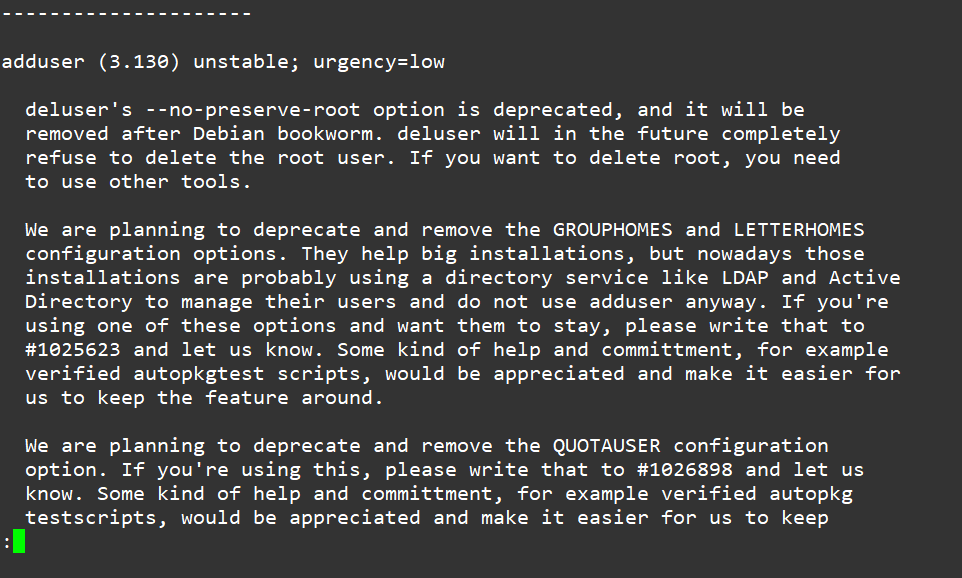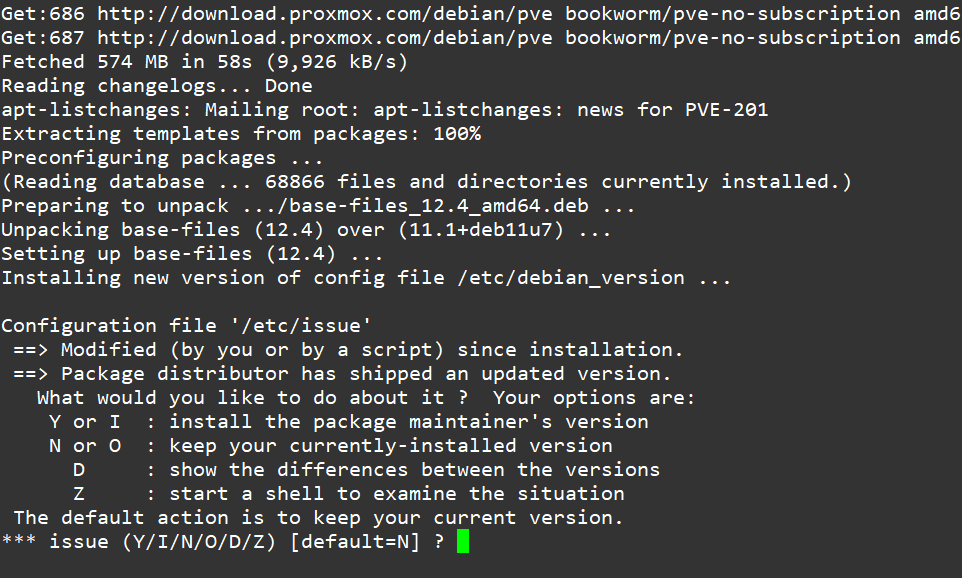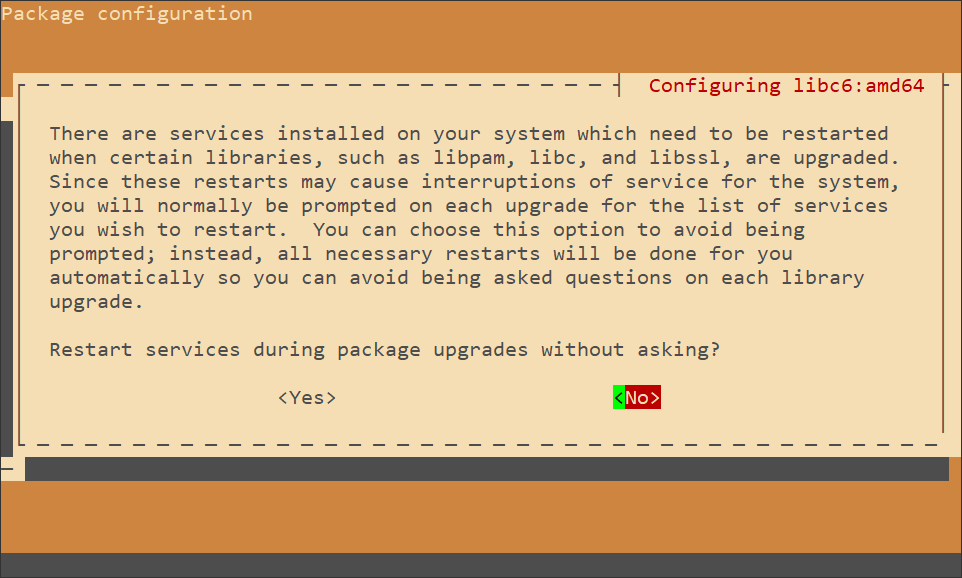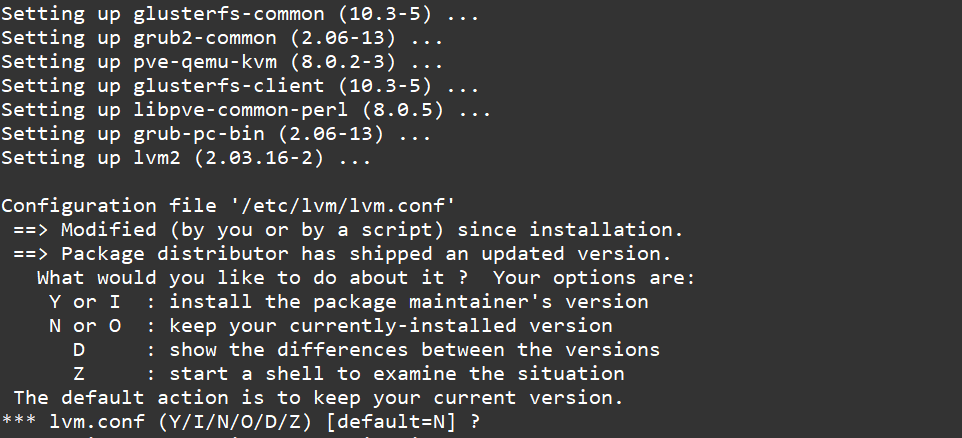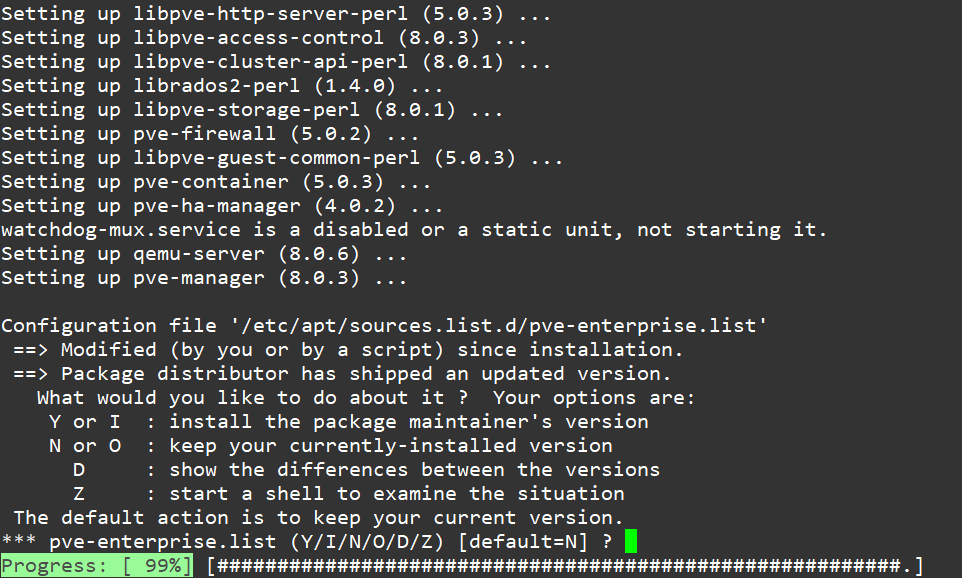Proxmox VE 7x to 8x 升級
Proxmox VE 已經釋放出新版的 8 版,改版內容如下或者連到官方看改版內容 官方 wiki 公告內容
官方最新消息 Proxmox Virtual Environment 8.0 with Debian 12 "Bookworm" released
此版改版內容
- Based on Debian Bookworm (12.0)
- Latest 6.2 Kernel as stable default
- QEMU 8.0.2
- LXC 5.0.2
- ZFS 2.1.12
- Ceph Quincy 17.2.6
Highlights
- New major release based on the great Debian Bookworm.
- Seamless upgrade from Proxmox VE 7.4, see Upgrade from 7 to 8
- Ceph Quincy enterprise repository.
Access the most stable Ceph repository through any Proxmox VE subscription. - Add access realm sync jobs.
Synchronize users and groups from an LDAP/AD server automatically at regular intervals. - Integrate host network bridge and VNet access when configuring virtual guests into the ACL system of Proxmox VE.
With the newSDN.Useprivilege and the new/sdn/zones/<zone>/<bridge-or-vnet>/<vlan-tag>ACL object path, you can give out fine-grained usage permissions for specific networks to users. - Create, manage and assign resource mappings for PCI and USB devices for use in virtual machines (VMs) via API and web UI.
Mappings allow you to give out access to one or more specific device(s) to a user, without them requiring root access.
For setups that require VMs, with hardware passthrough to be able to (offline-) migrate to other nodes, mappings can be used to ensure that the VM also has a valid device for passthrough on the target node. - Add virtual machine CPU models based on the x86-64 psABI Micro-Architecture Levels and use the widely supported
x86-64-v2-AESas default for new VMs created via the web UI.
Thex86-64-v2-provides important extra features over the qemu64/kvm64 like SSE3, SSE4 and SSE4.1 and was slightly adapted to also provide AES support, improving performance of many computing operations dramatically.
See the Virtual Machines (KVM/QEMU) section for details. - Add new text-based UI mode for the installation ISO, written in Rust using the Cursive TUI (Text User Interface) library.
You can use the new TUI mode to workaround issues with launching the GTK based graphical installer, sometimes observed on both very new and rather old hardware.
The new text mode shares the code executing the actual installation with the existing graphical mode.
Changelog Overview
Enhancements in the web interface (GUI)
- The Ceph repository selection now takes into account the subscription status of the complete cluster and recommends the optimal version for the cluster.
- Improved Dark color theme:
The Dark color theme, introduced in Proxmox VE 7.4, received a lot of feedback from our community, which resulted in further improvements. - Set strict
SameSiteattribute on the Authorization cookie - The Markdown parser, used in notes, has been improved:
- it allows setting the target for links, to make any link open in a new tab or window.
- it allows providing URLs with a scheme different from HTTP/HTTPS;
You can now directly link to resources likerdp://<rest-of-url>, providing convenience links in the guest notes. - tag-names and protocols are matched case-insensitive.
- The mobile UI code was refactored to not suffer from incompatible changes made for the web-based GUI.
- The generated CSR used by the built-in ACME client now sets the correct CSR version (
0instead of2). - Uploading files now only computes the MD5 sum of the uploaded file, if it can be used for comparison with the user-provided one.
- Firewall settings: Improve the alignment of permissions checked by the web UI with the permissions actually required by the API.
- Explicitly disallow internal-only
tmpfilenameparameter for file uploads. - Fix multipart HTTP uploads without
Content-Typeheader. - Show Ceph pool number in the web UI, as it is often mentioned in Ceph warnings and errors.
- You can now set the
subdiroption of the CIFS storage type in the web interface, not only via API/CLI. - Improved translations, among others:
- Ukrainian (NEW)
- Japanese
- Simplified Chinese
- Traditional Chinese
- The size units (Bytes, KB, MiB,...) are now passed through the translation framework as well, allowing localized variants (e.g., for French).
- The language selection is now localized and displayed in the currently selected language
Virtual machines (KVM/QEMU)
- New QEMU version 8.0:
- The
virtiofsdcodebase was replaced by a new and improved implementation based on Rust, which is packaged separately. - QEMU Guest Agent now has initial support for NetBSD and OpenBSD.
- Many more changes, see the upstream changelog for details.
- The
- Add virtual machine CPU models based on the x86-64 psABI Micro-Architecture Levels.
The x86-64 levels provide a vendor-agnostic set of supported features and reported CPU flags.
Models likex86-64-v2-AESprovides important extra features over the qemu64/kvm64 like SSE3, SSE4 and SSE4.1 and was slightly adapted to also provide AES support, improving performance of many computing operations dramatically.
This model is well-supported by all x86-64 hardware released in the last decade, to be specific since Intel Westmere (launched in 2010) and AMD Opteron 6200-series "Interlagos" (launched in 2011), enabling Proxmox VE to use it as the default CPU model for crating new VMs via the web UI. - Create, manage and assign resource mappings for PCI and USB devices for use in VMs via API and web UI.
Mappings allow you to give out access to one or more specific device(s) to a user, without them requiring root access.
For setups that require VMs, with hardware passthrough to be able to (offline-) migrate to other nodes, mappings can be used to ensure that the VM also has a valid device for passthrough on the target node.
New ACL object paths:/mapping/pci/<id>and/mapping/usb/<id>refer to the defined PCI and USB mappings.
New privileges:Mapping.Auditallows to view resource mappings,Mapping.Modifyallows to create or edit resource mappings, and Mapping.Use allows to pass through devices to VMs using the mapping.
New roles:PVEMappingUser, with the privilege to view and use mappings, and PVEMappingAdmin with the additional privilege to edit mappings. - Avoid invalid
smmmachine flag foraarch64VM when using serial display and SeaBIOS. - Warn if a network interface is not connected to a bridge on VM startup. This can happen if the user manually edited the VM config.
- Fix an issue with the improved code for volume size information gathering for passed through disks during backup preparation.
- Workaround breaking driver changes in newer Nvidia grid drivers, which prevented mediated devices (mdev) to be reclaimed upon guest exit.
- Prefer an explicit configured SMBIOS UUID for Nvidia vGPU passthrough.
If auuidcommand line parameter is present, it will be preferred over the default auto-generated UUID, containing the VMID and mdev index.
This fixes an issue, with software inside the guest, which relies on a specific and unique UUID setting. - Improved gathering of current setting for live memory unplugging.
- Avoid sending a temporary size of zero to QEMU when resizing block devices. Previously, this was done when resizing RBD volumes, but it is not necessary anymore.
- When resizing a disk, spawn a worker task to avoid HTTP request timeout (issue 2315).
- Allow resizing qcow2 disk images with snapshots (issue 517).
- cloud-init improvements:
- Introduce
ciupgradeoption that controls whether machines should upgrade packages on boot (issue 3428). - Better align privilege checks in the web UI with the actual privileges required in the backend.
- Fix an issue where the hostname was not properly set on Fedora/CentOS machines, by passing the hostname via the
fqdnoption. - Fix an issue where displaying pending changes via
qmandpveshcaused an error. - Allow setting network options with
VM.Config.Cloudinitprivileges, instead of requiring the more powerfulVM.Config.Networkprivilege.
- Introduce
- Drop unused QMP commands for getting the link and creating/deleting internal snapshots.
- Replace usages of deprecated
-no-hpetQEMU option with the hpet=off machine flag.
Containers (LXC)
- Improve handling of
/etc/machine-idon clone operations - the file is now only truncated, if the source did not explicitly set it to 'uninitialized' or remove it. Thus, the admin can decide if they want first-boot semantics or not (see machine-id (5)). - Set
memory.highcgroup limit to 99.6% of configured memory. This setting gives the container a chance to free memory before directly running into an Out-of-Memory (OOM) condition. It is applied onlxc.confgeneration and on hot-plugging memory to a running container. - Warn users on conflicting, manual,
lxc.idmapentries.
Custom uid/gid map entries can become quite complicated and cause overlaps fast.
By issuing a warning upon container start, the user should find the wrong entry directly. - When resizing a disk, perform plausibility checks already before spawning the worker task. This allows invalid requests to fail earlier.
- General code improvements, adhering to best practices for Perl code.
General improvements for virtual guests
- When cloning guests, the validation of the provided name of the clone is now happening in the frontend, improving UX.
HA Manager
- Stability improvements of manual maintenance mode:
- Fix an issue where a request for enabling maintenance mode on a node is lost, in case the rebooted node is the current active Cluster Resource Manager (CRM).
- Fix an issue where a shutdown policy other than
migratecould cause a node in maintenance mode to leave maintenance mode too early or fence itself. - Fix an issue where ha-rebalance-on-start could cause a newly added and already-running service to be shut down and migrated to another node
Now,ha-rebalance-on-startignores services that are already running.
- When enabling or disabling maintenance mode via the CLI, the
ha-managercommand now checks whether the provided node exists.
This avoids misconfigurations, e.g., due to a typo in the node name.
Improved management for Proxmox VE clusters
- The
rsyncinvocation used when joining nodes via ssh, which is deprecated, has been adapted to changes inrsyncCLI argument parsing in Bookworm.
Backup/Restore
- Improve performance of backups that use
zstdon fast disks, by invoking zstd without the--rsyncableflag (issue 4605). - Suppress harmless but confusing "storing login ticket failed" errors when backing up to Proxmox Backup Server.
- When restoring from backups via the web interface, the VM/CT name is now validated client-side before sending an API request. This helps catching invalid names early.
- The web UI now sorts backups by date, whereas it previously sorted backups first by VMID and then by date. The VMID is added as an extra column for users who would like to restore the previous sorting order (issue 4678).
- Fix an issue where the backup job editor window occasionally did not show the selected guests (issue 4627).
- The
fs-freeze-on-backupoption of the QEMU guest agent, which controls whether the filesystem should be frozen for backups, can now be set in the web UI. - Improve permission model for backup jobs: Editing backup jobs now generally requires the
Datastore.Allocateprivilege on the target storage, and editing backup jobs withdumpdirrequires root privileges. - Clarify description of the
ionicesetting.
Storage
- The file-based storage-types have two new config options
create-base-pathandcreate-subdirs. They replace the mkdir option and separate two different concepts:
create-base-pathdecides if the path to the storage should be created if it does not exist,
create-subdirsdecides if the content-specific sub-directories (guest images, ISO, container template, backups) should be created. - Conflating both settings in the single mkdir option caused a few unwanted effects in certain situations (issue 3214).
- The CIFS storage type can now be configured with custom mount options, as it was already possible for the NFS storage type.
- The
subdiroption of the CIFS storage type can now be configured in the web interface. The option can be used to mount a subdirectory of a SMB/CIFS share and was previously only accessible via the API/CLI. - Improve API documentation for the upload method.
- The API now allows to also query replication jobs that are disabled.
- Allow
@in directory storage path, as it is often used to signify Btrfs subvolumes. - When resizing RBD volumes, always round up sizes to the nearest integer. This avoids errors due to passing a floating-point size to the RBD tooling.
Ceph
- Add support for new Ceph enterprise repositories. When installing Ceph via
pveceph installor the web UI, you can now choose between thetest,no-subscriptionandenterprise(default) repositories. The-test-repositoryoption of thepveceph installcommand was removed. - Add
pveceph osddetailscommand to show information about OSDs on the command line, with a level of detail that is comparable to the web UI/API. - Drop support for Ceph Octopus and Pacific, as they are not supported in Proxmox VE 8.
- Remove overly restrictive validation of
public_networkduring monitor creation. Configuring a public network like0::/0or0::/1caused a superfluous "value does not look like a valid CIDR network" error. - The Ceph installation wizard in the web UI does not create monitors and managers called
localhostanymore and uses the actual node name instead.
Access control
- Add possibility to define realm sync jobs in the web UI. These allow to synchronize users and groups from an LDAP server automatically at regular intervals.
- Add TFA/TOTP lockout to protect against an attacker who has obtained the user password and attempts to guess the second factor:
- If TFA failed too many times in a row, lock this user account out of TFA for an hour. If TOTP failed too many times in a row, disable TOTP for the user account. Using a recovery key will unlock a user account.
- Add
pveum tfa unlockcommand and/access/users/{userid}/unlock-tfaAPI endpoint for manually unlocking users. - Add TFA lockout status to responses of
/access/tfaand/access/usersendpoints.
- Fix validity check for LDAP base DNs that was overly strict starting from Proxmox VE 7.4. For example, the check rejected base DNs containing both dashes and spaces (issue #4609).
- When authenticating via PAM, pass the PAM_RHOST item. With this, it is possible to manually configure PAM such that certain users (for example
root@pam) can only log in from certain hosts. - Add
pveum tfa listcommand for listing second factors on the command line. - The
access/ticketAPI endpoint does not support the deprecated login API (usingnew-format=0) anymore. - Remove the
Permission.Modifyprivilege from thePVESysAdminandPVEAdminroles and restrict it to theAdministratorrole. This reduces the chances of accidentally granting privilege modification privileges. - Login with TFA: In order to improve UX, fix wording of messages related to recovery keys.
- Forbid creating roles with names starting with
PVEto reserve these role names for use in future upgrades. SDN.Useis required on a bridge/vnet (or its zone) in order to configure it in a guest vNIC.- use
/sdn/zones/localnetworkor/sdn/zones/localnetwork/<bridge>to allow usage of all or specific local bridges. - use
/sdn/zones/<zone>or/sdn/zones/<zone>/<bridge>to allow usage of all or specific vnets in a given SDN zone.
- use
- Users with
VM.Allocate/Datastore.Allocate/Pool.Allocateprivileges, but without thePermissions.Modifyprivilege, can now only assign a subset of their own privileges to specific VM/storage/pool paths, instead of arbitrary roles.
Firewall & Software Defined Networking
- Allow to distinguish IP sets and aliases with the same name defined on the datacenter level and on the guest level by providing an explicit prefix (issue 4556). Previously, the innermost IP set/alias took precedence, which is still the default behavior if no prefix is provided.
- Fix an issue where an allowed special ICMP-type could accidentally be added as destination port for a layer 4 protocol, breaking firewall rule loading.
- Fix setting the correct vlan-protocol for QinQ zones if the bridge is vlan-aware.(issue 4683)
- Fix an issue where routing between zones was enabled by default in exit nodes. This has been fixed by adding null-routes for each other zone prefix to each zone (issue 4389).
- Correctly order
vrfandrouter bgp vrfentries by vrf name in thefrrconfiguration. (issue 4662) - For setups where a node is primary exit node for one vrf and secondary exit for a different vrf, the configuration now also adds the second vrf's default route. (issue 4657)
- Allow specifying a custom vxlan-tunnel port per interface.
- Update the
frrconfiguration generation to the version offrrshipped in Debian Bookworm. - Fix an issue where reloading the network configuration on a remote node created an error, which hid the actual issue with the network configuration.
- Add support for IPv6 SLAAC and router advertisement configuration in
/etc/network/interfacestoifupdown2. - Fix live reloading when changing VLAN and VXLAN specific attributes.
- Add support for creating an
OVSbridge which tags traffic with a specific VLAN tag toifupdown2.
This is to match the possibility inifupdown.
Improved management of Proxmox VE nodes
pve7to8compatibility check script added.
As with previous major upgrades, Proxmox VE 7 ships a script checking for issues with the current node/cluster. It should point to any issues which might prevent a successful major upgrade.- Outdated
pve6to7compatibility check script was removed. - Fix an issue where the web UI would display no APT repositories during a major upgrade.
- The new version of
grub2provided by Debian Bookworm (2.06-13) fixes an issue where a host using LVM would fail to boot with a messagedisklvmid/...not found, even though the LVM setup is healthy.
Installation ISO
- Add new text-based UI mode for the installation ISO, written in Rust using the Cursive TUI (Text User Interface) library.
You can use the new TUI mode to workaround issues with launching the GTK based graphical installer, sometimes observed on both very new and rather old hardware.
The new text mode shares the code executing the actual installation with the existing graphical mode. - The version of BusyBox shipped with the ISO was updated to version 1.36.1.
- The Ceph Quincy repository provided by Proxmox is configured by default to deliver updates for the Ceph client, even if no Proxmox Ceph hyper-converged server is set up.
- Detection of unreasonable system time.
If the system time is older than the time the installer was created, the system notifies the user with a warning. ethtoolis now shipped with the ISO and installed on all systems.systemd-bootis provided by its own package instead of systemd in Debian Bookworm and is installed with the new ISO.
Notable bugfixes and general improvements
- Most git repositories now have a
dscMakefile target to create a Debian Source Package and additionally asbuildtarget to create the source package and build it using sbuild.
Known Issues & Breaking Changes
Storage
- Storage activation now checks that every content type uses a different directory, in order to prevent unexpected interactions between different content types.
This breaks setups in which thecontent-dirsoption was set up to map different content types to the same directory, and setups in which some content directories were manually set up as symlinks to a common directory. - The
mkdiroption is considered deprecated, it got split intocreate-base-pathandcreate-subdirsas fine-grained replacement.
While Proxmox VE will continue to support this option during the 8.x release series, we recommend switching over to the new options already now.
QEMU
- QEMU 8.0 removed some previously deprecated features. Proxmox VE 8 won't use the
-chardev ttyand-chardev parportaliases anymore, and no other features were used by the Proxmox VE stack. Thus, only installations usingargsinside their guest configs need to check the compatibility. See the Qemu changelog on the topic for details.
- The removed features in QEMU 8.0 also include the Proxmox VE-specific, but unused/deprecated QMP commands
get_link_status,snapshot-driveanddelete-drive-snapshot.
- The removed features in QEMU 8.0 also include the Proxmox VE-specific, but unused/deprecated QMP commands
- Only root@pam is now allowed to clone and restore guests with passed through PCI/USB devices that are not using the new mapping feature. To allow regular users to clone and restore with PCI/USB devices, create a mapping and give the user 'Mapping.Use' on that.
- Trying to pass through the same PCI device multiple times in a single guest now fails earlier. A
qm showcmdfor example does not generate an output anymore in that case. - When passed through device is configured as
multifunction(or 'All Functions' in the web UI) with a set mediated device (mdev) this now generates an error instead of a warning. Use the specific function instead. - cloud-init: If the VM name is not a FQDN and no DNS search domain is configured, the automatically-generated cloud-init user data now contains an additional
fqdnoption. This fixes an issue where the hostname was not set properly for some in-guest distributions. However, the changed user data will change the instance ID, which may cause the in-guest cloud-init to re-run actions that trigger once-per-instance. For example, it may regenerate the in-guest SSH host keys. - Migration doesn't scan all local storages for orphaned volumes anymore. Instead, only the volumes referenced in the configuration (including snapshots) are picked up. This avoids unexpected errors where an unavailable local storage could fail migration even if no volume referenced that storage.
Container
- The
lxc.id_mapconfiguration key has been deprecated for a long time bylxcand was replaced bylxc.idmap. With this release, its presence is considered an error. The key can only be present if it was manually added to a guest configuration. - The
lxcfsis now built withfuse 3. This upgrade is done on a major release, since all running containers need to be restarted afterwards. - Migration doesn't scan all local storages for orphaned volumes anymore. Instead, only the volumes referenced in the configuration (including snapshots) are picked up. This avoids unexpected errors where an unavailable local storage could fail migration even if no volume referenced that storage.
Authentication & Permission System
- There is a new
SDN.Useprivilege (and corresponding PVESDNUser role) that is required to configure virtual NICs in guests. See "Access control" section above for details! - The
Permission.Modifyprivilege has been removed from thePVESysAdminandPVEAdminroles, in order to reduce the chances of accidentally granting the privilege to modify privileges. If a particular setup requires a role with this privilege, it is necessary to define a new custom role and use that instead ofPVESysAdmin/PVEAdmin. - Users with
VM.Allocate/Datastore.Allocate/Pool.Allocateprivileges, but without thePermissions.Modifyprivilege, can now only assign a subset of their own privileges to specific VM/storage/pool paths. Previously they could assign any role to specific VM/storage/pool paths. As the privileges usable on specific VM/storage/pool paths were quite limited, this did not allow privilege escalation, but restricting the capabilities now allows adding more powerful privileges in future versions without breaking changes. - Editing backup jobs now generally requires the
Datastore.Allocateprivilege on the target storage, and editing backup jobs withdumpdirrequires root privileges. - User accounts will now be locked after too many attempts to authenticate with a second factor. This is intended to protect against an attacker who has obtained the user password and attempts to guess the second factor. Unlocking requires either a successful login with a recovery key or a manual unlock by an administrator.
Node Management
- Systems booting via UEFI from a ZFS on root setup should install the
systemd-bootpackage after the upgrade.
Thesystemd-bootwas split out from the systemd package for Debian Bookworm based releases. It won't get installed automatically upon upgrade from Proxmox VE 7.4 as it can cause trouble on systems not booting from UEFI with ZFS on root setup by the Proxmox VE installer.
Systems which have ZFS on root and boot in UEFI mode will need to manually install it if they need to initialize a new ESP (see the output ofproxmox-boot-toolstatus and the [relevant documentation). Note that the system remains bootable even without the package installed (the boot-loader that was copied to the ESPs during intialization remains untouched), so you can also install it after the upgrade was finished.
It is not recommended installingsystemd-booton systems which don't need it, as it would replacegrubas bootloader in itspostinstscript.
Others
- The API can handle array-type data differently, while staying backward compatible.
Instead of being able to pass the individual elements separated by null bytes, you can pass the data directly as array.
7版更新到8版
如何更新到 8 版,官方有建議先更新到 7 版最新版次之後再進行更新到 8 版,目前 7 版最新版次為 7.4-15
- 更新 8 版指令
apt update && apt dist-upgrade -y
更新完建議重開機
reboot -nf
- 先下「
pve7to8」檢清更新的清單,執行結果如下
pve7to8
- 啟用所有檢查的情況
pve7to8 --full
- 更新來源庫
apt update
apt dist-upgrade
- 修改
PVE非訂閱版及Debian系統底層來源庫sources.list內容,把PVE非訂閱版及Debian系統底層 來源庫從Bullseye源庫指向到Bookworm源庫
sed -i 's/bullseye/bookworm/g' /etc/apt/sources.list
- 修改
Ceph非訂閱來源庫
sed -i 's/bullseye/bookworm/g' /etc/apt/sources.list.d/ceph.list
以上所設定的來源庫是 非訂閱 版本,如果您有跟原廠 訂閱 服務,以下是修改 訂閱 版源庫位置,或者請洽您所配合廠商或者與本工作室協助您處理。
- 修改 訂閱 版來源庫
pve-enterprise.list,沒有在使用 訂閱 版來源庫記得註解該源庫,或者從GUI介面修改停用此源庫
sed -i -e 's/bullseye/bookworm/g' /etc/apt/sources.list.d/pve-install-repo.list
- 修改
Ceph訂閱 版來源庫
sed -i -e 's/bullseye/bookworm/g' /etc/apt/sources.list.d/ceph.list
更新到 8 版
- 以上流程跑完之後就可以開始更新到 8 版
apt update && apt dist-upgrade -y
- 跑到一半會出現此訊息,只要按下 enter 繼續更新
- 更新詢問訊息,只要預設就可以了直接按下
Enter鍵即可
- 選擇
NO
- 輸入
NO
- 輸入
NO更新完後再重啟系統再登入就可以看到畫面已更新到8版表您已更新成功了

